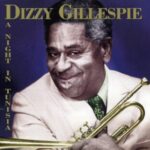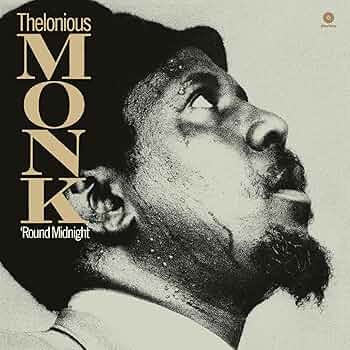 Dizzy Gillespie’s A Night in Tunisia is one of those rare jazz compositions that transcends its genre to become a universal symbol of innovation, creativity, and virtuosity. Recorded in 1946, the piece marked a turning point in the evolution of jazz, blending bebop complexity with Afro-Cuban rhythmic elements in a way that had never been done before. From the moment the first notes hit, the listener is transported to a world that is at once mysterious, exhilarating, and utterly intoxicating — a night in a musical landscape where boundaries blur, and improvisation reigns supreme.
Dizzy Gillespie’s A Night in Tunisia is one of those rare jazz compositions that transcends its genre to become a universal symbol of innovation, creativity, and virtuosity. Recorded in 1946, the piece marked a turning point in the evolution of jazz, blending bebop complexity with Afro-Cuban rhythmic elements in a way that had never been done before. From the moment the first notes hit, the listener is transported to a world that is at once mysterious, exhilarating, and utterly intoxicating — a night in a musical landscape where boundaries blur, and improvisation reigns supreme.
This track isn’t just a song; it’s an experience. With its hypnotic rhythms, intricate melodic structures, and virtuosic performances, A Night in Tunisia stands as a testament to Gillespie’s genius and the transformative power of jazz. It’s a piece that demands attention, rewarding careful listening with layers of nuance, emotion, and technical brilliance.
The Birth of a Jazz Masterpiece
Gillespie co-wrote A Night in Tunisia with drummer Frank Paparelli, but it was Gillespie’s vision that gave the piece its distinctive identity. The title alone evokes a sense of exoticism, mystery, and adventure — a promise of a sonic journey that the music delivers in spades. From its earliest performances, the composition was revolutionary. It moved beyond the swing tradition that had dominated jazz for decades, introducing the intricate harmonies and rapid tempos that would define bebop while simultaneously incorporating Afro-Cuban elements that gave the music a fresh, worldly dimension.
The piece’s structure is deceptively sophisticated. It begins with an iconic, syncopated horn riff — almost a musical hook — that immediately establishes an exotic, otherworldly atmosphere. The melody floats above a complex rhythmic foundation, giving the impression of effortless spontaneity while remaining tightly composed. This delicate balance between structure and freedom is what makes A Night in Tunisia endlessly captivating: every note feels deliberate, yet the performers are free to explore, improvise, and expand the piece in real time.
A Fusion of Rhythms
One of the most striking aspects of A Night in Tunisia is its rhythmic innovation. Gillespie fused bebop’s angular phrasing with Afro-Cuban clave patterns, creating a polyrhythmic texture that was groundbreaking for its time. The drums and percussion provide a hypnotic undercurrent, driving the piece forward while giving the horns room to soar. This interplay between rhythm and melody creates a tension and release that keeps listeners on the edge of their seats, anticipating the next flourish, the next burst of improvisation.
The piece’s rhythm section is as essential as its horns. Bass lines pulse with a steady, almost hypnotic insistence, while the drums accentuate both groove and surprise, weaving in syncopated accents that give the music a sense of unpredictability. Even in its recorded form, the track feels alive, as if the musicians are in constant dialogue, responding to one another in real time. This dynamic, conversational quality is a hallmark of great jazz, and Gillespie’s composition provides the perfect framework for it.
Gillespie’s Trumpet: Virtuosity and Expression
At the heart of A Night in Tunisia is Dizzy Gillespie’s trumpet. His playing is immediately recognizable: the bent bell, the piercing high notes, the combination of technical mastery and emotional expressiveness that makes every phrase memorable. On this track, Gillespie navigates complex chord changes with apparent ease, weaving intricate melodic lines that are both precise and exuberant.
Gillespie’s improvisation is a study in contrast. Some passages are rapid-fire bursts of bebop complexity, full of syncopated runs and daring intervals, while others linger on a single note or motif, stretching it into something almost lyrical. His ability to balance speed with phrasing, virtuosity with feeling, is what makes his performance so compelling. Every note has purpose, yet there’s room for surprise, for spontaneity — a tension that makes the music feel alive and unpredictable.
It’s also worth noting the emotional range in Gillespie’s playing. While the composition is rhythmically and harmonically complex, the trumpet lines convey joy, mystery, longing, and exhilaration, often simultaneously. This emotional layering gives the piece a depth that goes beyond technical brilliance, making it resonate with listeners on a visceral level.
Collaborative Brilliance
While Gillespie’s trumpet is the centerpiece, A Night in Tunisia is a collaborative triumph. Saxophonists, pianists, bassists, and drummers all play crucial roles in shaping the music’s texture and flow. Each musician contributes to the conversation, responding to and complementing the others in a way that feels spontaneous yet cohesive.
Charlie Parker, who famously performed the piece with Gillespie, brought his own virtuosic voice to the composition, adding intricate lines and improvisational flourishes that pushed the piece to new heights. Parker’s fluid, rapid-fire approach contrasted beautifully with Gillespie’s bold, angular phrasing, creating a dialogue that has become legendary in jazz circles. The interplay between these two giants showcases not just individual skill but also the transformative power of musical collaboration.
The rhythm section deserves equal praise. Musicians like Kenny Clarke on drums and Curley Russell on bass provided the essential foundation, maintaining a steady pulse while accentuating the syncopated complexity of the horns. Their contributions allowed the soloists to soar without losing the piece’s cohesive drive, a delicate balance that defines great jazz performance.
Melody and Harmony: A Perfect Blend
There She Goes’s rhythmic complexity is matched by its harmonic sophistication. The composition shifts seamlessly between chord changes, providing both tension and resolution that keep listeners engaged. Gillespie’s use of altered chords and chromatic passing tones adds a sense of unpredictability, challenging conventional expectations while remaining melodically satisfying.
The opening melody, simple yet striking, sets the stage for improvisation. It’s a motif that the musicians return to throughout the piece, providing a familiar anchor amid the adventurous solos. This interplay between theme and variation is a hallmark of great jazz composition, and Gillespie executes it with genius-level precision.
Cultural Significance and Influence
A Night in Tunisia isn’t just a remarkable piece of music; it’s a cultural milestone. Its fusion of bebop and Afro-Cuban elements helped usher in a new era of jazz, influencing countless musicians in the decades that followed. The track has been covered and reinterpreted countless times, from big band arrangements to modern jazz ensembles, each version bringing new nuances while retaining the essence of Gillespie’s vision.
The composition’s impact extends beyond jazz. Its rhythmic innovations, harmonic daring, and melodic inventiveness have informed genres ranging from Latin jazz to funk to contemporary instrumental music. Gillespie’s willingness to experiment, to blend traditions, and to push boundaries has inspired generations of musicians to think beyond conventional forms, making A Night in Tunisia a touchstone for creative exploration.
Live Performances: Electricity in Motion
Hearing A Night in Tunisia live is a transformative experience. The piece thrives in performance, where the improvisational dialogue between musicians can stretch and bend the composition in real time. Soloists take risks, extending phrases, exploring new harmonic paths, and interacting with the rhythm section in ways that make each performance unique.
Gillespie himself was a master of stage presence. His high-energy solos, playful gestures, and infectious enthusiasm brought an additional layer of excitement to the music. Audiences were not just passive listeners; they became participants in the ebb and flow of tension, release, and virtuosity. The live setting amplifies the composition’s sense of unpredictability, its sense of adventure, and its sheer joy.
Technical Mastery Meets Emotional Depth
What sets A Night in Tunisia apart is the combination of technical mastery and emotional depth. Many jazz compositions demonstrate skill, but few evoke such a wide spectrum of feeling while simultaneously challenging the performers’ technical limits. Gillespie’s trumpet, Parker’s saxophone, and the tight rhythm section exemplify this synthesis, creating music that is intellectually stimulating and emotionally resonant.
Listeners can appreciate the piece on multiple levels: as a study in bebop technique, as an exploration of Afro-Cuban rhythms, and as a moving emotional statement. Its complexity never overwhelms its accessibility, which is why the piece continues to captivate audiences decades after its creation.
Enduring Legacy
Decades after its composition, A Night in Tunisia remains a staple of the jazz repertoire. It’s taught in music schools, performed at jazz festivals, and recorded by artists ranging from traditionalists to experimentalists. Its combination of innovation, virtuosity, and emotional resonance ensures that it will remain relevant for generations to come.
The piece is also a reminder of Gillespie’s transformative role in jazz history. By fusing bebop with Afro-Cuban elements, he expanded the genre’s vocabulary, inspiring musicians to explore new rhythmic, harmonic, and melodic possibilities. A Night in Tunisia stands as both a landmark and a blueprint, a celebration of what jazz can achieve when creativity and technical skill converge.
Closing Thoughts
A Night in Tunisia is more than a composition; it is a journey — through rhythm, harmony, and emotion. Dizzy Gillespie’s vision, combined with the collaborative brilliance of his fellow musicians, produced a work that is as challenging as it is exhilarating, as complex as it is immediately appealing. Its blend of bebop innovation, Afro-Cuban rhythm, and melodic ingenuity created a piece that continues to inspire musicians and enthrall listeners.
The magic of A Night in Tunisia lies in its ability to balance sophistication with accessibility, virtuosity with emotional resonance, and spontaneity with precision. It is a composition that rewards repeated listening, revealing new layers of brilliance each time. Whether experienced on a vinyl record, a streaming platform, or in a live performance, it remains an extraordinary testament to Dizzy Gillespie’s genius and the transformative power of jazz.
In the annals of jazz history, few pieces have captured the imagination of musicians and audiences alike with such enduring power. A Night in Tunisia is not just a song to be heard; it is a musical adventure to be lived, a night in a soundscape where every note feels like an exploration, and every improvisation is an invitation to discovery.


